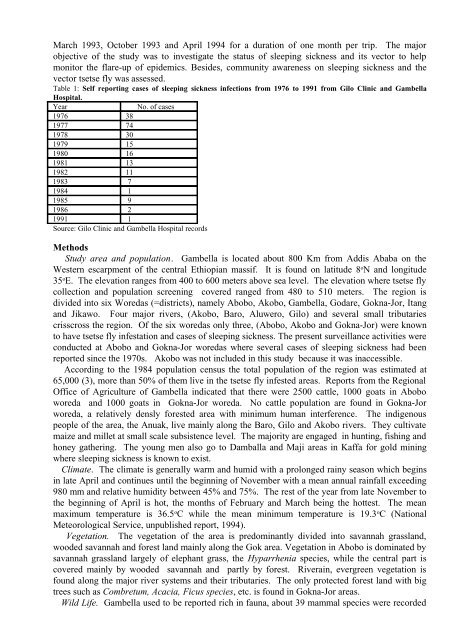Original article - Ethiopian Review
Original article - Ethiopian Review
Original article - Ethiopian Review
- No tags were found...
Create successful ePaper yourself
Turn your PDF publications into a flip-book with our unique Google optimized e-Paper software.
March 1993, October 1993 and April 1994 for a duration of one month per trip. The majorobjective of the study was to investigate the status of sleeping sickness and its vector to helpmonitor the flare-up of epidemics. Besides, community awareness on sleeping sickness and thevector tsetse fly was assessed.Table 1: Self reporting cases of sleeping sickness infections from 1976 to 1991 from Gilo Clinic and GambellaHospital.Year No. of cases1976 381977 741978 301979 151980 161981 131982 111983 71984 11985 91986 21991 1Source: Gilo Clinic and Gambella Hospital recordsMethodsStudy area and population. Gambella is located about 800 Km from Addis Ababa on theWestern escarpment of the central <strong>Ethiopian</strong> massif. It is found on latitude 8 o N and longitude35 o E. The elevation ranges from 400 to 600 meters above sea level. The elevation where tsetse flycollection and population screening covered ranged from 480 to 510 meters. The region isdivided into six Woredas (=districts), namely Abobo, Akobo, Gambella, Godare, Gokna-Jor, Itangand Jikawo. Four major rivers, (Akobo, Baro, Aluwero, Gilo) and several small tributariescrisscross the region. Of the six woredas only three, (Abobo, Akobo and Gokna-Jor) were knownto have tsetse fly infestation and cases of sleeping sickness. The present surveillance activities wereconducted at Abobo and Gokna-Jor woredas where several cases of sleeping sickness had beenreported since the 1970s. Akobo was not included in this study because it was inaccessible.According to the 1984 population census the total population of the region was estimated at65,000 (3), more than 50% of them live in the tsetse fly infested areas. Reports from the RegionalOffice of Agriculture of Gambella indicated that there were 2500 cattle, 1000 goats in Aboboworeda and 1000 goats in Gokna-Jor woreda. No cattle population are found in Gokna-Jorworeda, a relatively densly forested area with minimum human interference. The indigenouspeople of the area, the Anuak, live mainly along the Baro, Gilo and Akobo rivers. They cultivatemaize and millet at small scale subsistence level. The majority are engaged in hunting, fishing andhoney gathering. The young men also go to Damballa and Maji areas in Kaffa for gold miningwhere sleeping sickness is known to exist.Climate. The climate is generally warm and humid with a prolonged rainy season which beginsin late April and continues until the beginning of November with a mean annual rainfall exceeding980 mm and relative humidity between 45% and 75%. The rest of the year from late November tothe beginning of April is hot, the months of February and March being the hottest. The meanmaximum temperature is 36.5 o C while the mean minimum temperature is 19.3 o C (NationalMeteorological Service, unpublished report, 1994).Vegetation. The vegetation of the area is predominantly divided into savannah grassland,wooded savannah and forest land mainly along the Gok area. Vegetation in Abobo is dominated bysavannah grassland largely of elephant grass, the Hyparrhenia species, while the central part iscovered mainly by wooded savannah and partly by forest. Riverain, evergreen vegetation isfound along the major river systems and their tributaries. The only protected forest land with bigtrees such as Combretum, Acacia, Ficus species, etc. is found in Gokna-Jor areas.Wild Life. Gambella used to be reported rich in fauna, about 39 mammal species were recorded




![to read the full report [pdf, Amharic] - Ethiopian Review](https://img.yumpu.com/52737829/1/190x245/to-read-the-full-report-pdf-amharic-ethiopian-review.jpg?quality=85)











